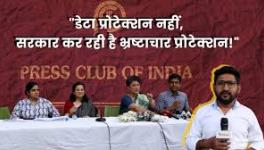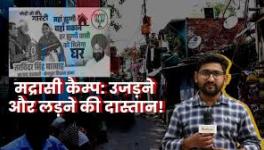The Question of Farm-Loan Waiver

Image Courtesy: ahlu-India.com
The question of farm-loan waiver that is being demanded by the peasantry is much misunderstood. Such a waiver, it is argued by critics, would vitiate the credit-culture in the country: people would stop repaying loans henceforth in expectation of waivers on them. Since the UPA government had waived farm-loans a few years ago and now again there is a demand for a farm-loan waiver, peasants, they contend, are getting into a habit of not paying loans and demanding periodic waivers instead. Somebody, it is further added, has to bear the burden of the loan after all; and if the peasants do not do so, then the government budget gets saddled with this burden, to the detriment of society as a whole. And so on.
FALLACIOUS UNDERSTANDING
All these arguments however, even if we assume that they are advanced in good faith, are based on a completely fallacious understanding. To see this, let us first examine how credit circulates in the economy. A peasant, let us assume, takes Rs 100 worth of loans for growing a crop whose value, for simplicity, is also Rs 100 at base prices. When the peasant goes to the market to sell the crop it is bought by the trader who takes a loan of Rs 100 from the bank for doing so; and this money in turn, which constitutes the peasant’s sale proceeds, is handed back to the bank by the peasant. The bank’s outstanding credit therefore continues to remain at Rs 100, but the identity of the borrower changes, as this credit circulates: originally it was the peasant who owed the bank Rs 100 but now the peasant is free of the loan, while it is the trader who comes to owe the bank Rs 100.
During this entire process of circulation of credit, however, there is always a stock of commodities of equal value against the outstanding credit. When the peasant takes credit to buy inputs, then obviously this stock of inputs is the equivalent of the credit taken; later the stock of produced commodity with the peasant becomes the equivalent of the credit taken; and still later the stock of commodity with the trader becomes the equivalent of the credit taken. As the credit circulates, the commodity form and the commodity location change; but there is always an equivalent stock in value terms. There is therefore no question of banks being “stressed” (except in cases of drought and other natural calamities). And when the stock of the commodity is finally sold to the consumer (who let us assume pays for it out of his/her income), the sale proceeds flow back to the bank in the form of loan repayment. Hence in the absence of natural calamities, if base prices continue to prevail, there is no reason why there should be any demand for loan waiver and any “stress” on the part of the banks. Bank credit in other words should be self-liquidating in the absence of shocks to output and prices.
The primary reason why loan-waiver is being demanded at present is not an output fall owing to any natural calamity; on the contrary this has been a bumper harvest year. It is the price-fall on account of the bumper harvest that underlies this demand, ie, because the base prices that had been assumed to prevail in the above example do not prevail. There is instead a price collapse. Let us see in terms of the above example what happens in such a case.
Typically in agriculture, since the bulk of the peasantry lacks stock-holding capacity, when output increases by say 10 per cent, prices collapse by more than 10 per cent, so that the total value of the crop falls for the producers. (The opposite, significantly, does not happen for the producers when there is a fall in output). In the above example therefore, against the credit of Rs 100 taken by the peasant, the value of the output sold by the peasant to the trader would be only, say, Rs 70. While the bank gives Rs 70 to the trader as a loan, which the latter uses to buy the crop, and this amount flows back to the bank through the peasant, Rs 30 does not flow back. The peasant has no means of paying back Rs 30 and the bank is saddled with a non-performing asset, viz, its loan to the peasant.
But while the trader has paid Rs 70 to the peasant for the crop, the amount for which he would sell the crop is not Rs 70, but more, in fact not less than the original Rs 100. The fall in crop prices whenever there is a bumper harvest is not passed on, certainly not fully passed on, to the consumers. When there was a crash in coffee prices for the growers in Kerala for instance, there was not an iota of a fall in the prices of instant coffee in the retail market. Today there is a crash in groundnut prices in Modi’s own home state, Gujarat, but this has not meant any fall in the price of groundnut oil for the consumers. Somewhere between the producer and the consumer, the effect of this fall is absorbed as larger profits. And I use the generic term “trader”, momentarily, to depict this beneficiary.
For such a trader therefore, while the loan from the bank has been Rs 70 in the above example, the value of the commodity stock held is Rs 100. Hence the fact that the peasant has a deficit of Rs 30 (and correspondingly, the bank has a problem of non-repayment of loan to the tune of Rs 30), has as its counterpart an improvement in the net worth position of the trader exactly to the same extent. But the bank cannot touch the trader to recover its loan; the peasant cannot touch the trader to obtain the resources for paying back his loan. (In fact the problem arose precisely because the peasant got a lower price from the trader, ie, could not get adequate resources from the latter for paying back the loan.)
The total outstanding credit in this case too is Rs 100, of which Rs 70 is advanced to the trader and Rs 30 (still unpaid) to the peasant. The commodity stocks with the trader still have a value of Rs 100 (at which they would be sold to the consumer). But the bank has no claims on these commodity stocks: its claims amount only to Rs 70. What we call the problem of non-repayment therefore is nothing else but a transfer from the peasant to the trader. The bank’s portfolio suffers because of this transfer. Now if the bank presses the peasant for a repayment of the remaining Rs 30, then the peasant will become destitute and may even commit suicide, as has been happening of late. Peasant resistance to waive the loan is an attempt to prevent such a fate from overtaking the peasant.
Several conclusions immediately follow from this simple illustration: first, non-repayment by the peasant is not the consequence of any bad “credit habit” on the part of the peasant. Second, even if there is a loan waiver now which makes the peasant free of all obligations to the bank, the same situation will again arise in the future. The fact that the demand for a loan waiver keeps getting repeated is not because the peasants, having benefited from it once, keep wanting to repeat it, ie, not because of greed or avarice on their part, but because the institutional structure in the economy is such they have to experience a price-crash whenever there is a bumper harvest. Third, the bank is faced with a bad debt not because the money it had loaned has vanished into thin air, but because it has got transferred into the pockets of traders which cannot be touched either by the peasants (who have no capacity to do so) or by the banks (who have no authority to do so).
BREAK DOWN OF INSTITUTIONAL MECHANISM
Those who are opposed to what they see as the peasants’ “habit” of asking for loan waivers, should rather insist that there should be appropriate institutions to prevent price-crashes in the event of bumper harvests. Prior to the implementation of neo-liberal policies, the country had in fact set up such an institutional mechanism. The Food Corporation of India announced support and procurement prices for 22 crops, and carried out procurement operations to make those prices effective. In the case of commercial crops there were several Commodity Boards, such as the Tea Board, the Coffee Board, and the Rubber Board, which carried out a marketing function that included intervening in the market in the event of a price-crash.
These interventions left much to be desired. Often the FCI would not be there in time to make the purchase. Often the poor peasants and even lower middle peasants, who had the least holding capacity, would have to sell their crop at throw-away prices before the FCI agents turned up in the market. Nonetheless there was at least an understanding of the problem and some effort at dealing with it. With neo-liberalism however there is a “rolling back”. True, the FCI still exists and intervenes in the market for several crops, though the crops it covers are much less than what the peasants need. (And sticking to the WTO agreement may even prevent such intervention in the coming days). But the marketing function of the Commodity Boards has completely ceased. And cash crops which such Boards deal with are the ones where the need for credit is most acute.
It is the breaking down of this institutional mechanism that is responsible for the peasants’ distress and periodic demands for loan-waivers. The beneficiaries of this breaking down have been what I have called “traders” till now, but these “traders” now include multinational agri-business, and the domestic corporate-financial oligarchy, all of whom have entered the market for agricultural goods. Not only must the peasants get a loan-waiver to tide over their present predicament, but they need to be provided price-support against future crashes by re-erecting a mechanism that neo-liberalism has destroyed.
Disclaimer: The views expressed here are the author's personal views, and do not necessarily represent the views of Newsclick.
Get the latest reports & analysis with people's perspective on Protests, movements & deep analytical videos, discussions of the current affairs in your Telegram app. Subscribe to NewsClick's Telegram channel & get Real-Time updates on stories, as they get published on our website.
























